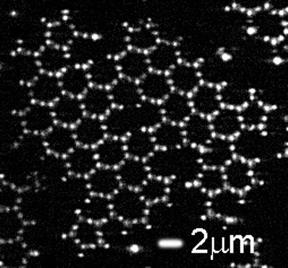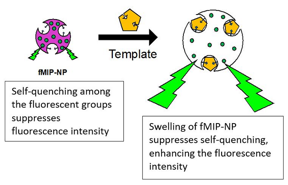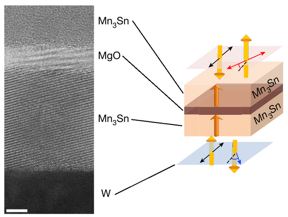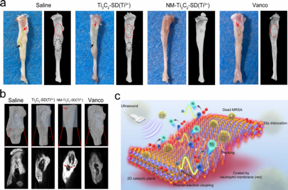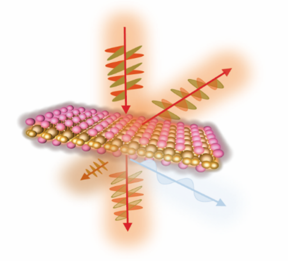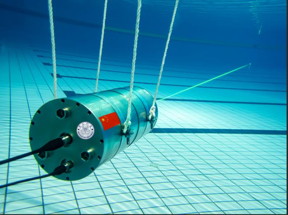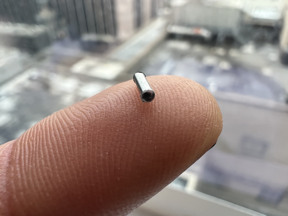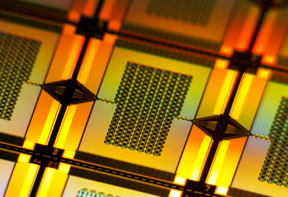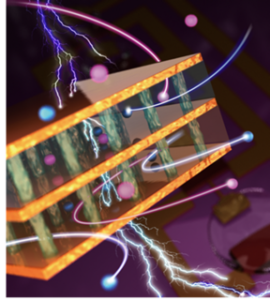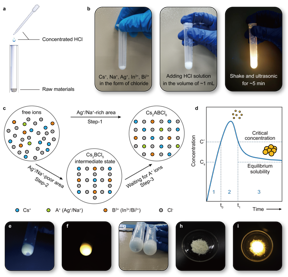ہوم پیج (-) > پریس > Finding the most heat-resistant substances ever made: UVA Engineering secures DOD MURI award to advance high-temperature materials
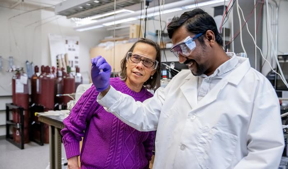 |
| Postdoctoral researcher Sandamal Witharamage (from left) is part of Professor Elizabeth J. Opila’s team developing novel planetary- and geologically inspired high-temperature materials under a Department of Defense Multidisciplinary University Research Initiative grant.
کریڈٹ |
خلاصہ:
The most durable, heat-resistant materials ever made could be hiding in plain sight.
اب تک بنائے گئے سب سے زیادہ گرمی سے بچنے والے مادوں کی تلاش: UVA انجینئرنگ نے اعلی درجہ حرارت والے مواد کو آگے بڑھانے کے لیے DOD MURI ایوارڈ حاصل کیا
Charlottesville, VA | Posted on December 8th, 2023
The U.S. Department of Defense wants to know if minerals and rocks found on Earth and in space hold the secrets of next-generation high-temperature materials. To find out, the DOD awarded $6.25 million through its Multidisciplinary University Research Initiative, or MURI, to a team from the University of Virginia and Arizona State University. The group is led by UVA’s Elizabeth J. Opila, the Rolls-Royce Commonwealth Professor and chair of the Department of Materials Science and Engineering.
The highly competitive MURI funds fundamental scientific research the DOD hopes will lead to breakthroughs in its areas of interest through collective insights from multiple disciplines.
چٹانوں کو پڑھنا
“It’s a boom time for high-temperature materials because of needs in energy production, hypersonics and new things like additive manufacturing coming on in the field,” Opila said. “[People are] exploring new compositional spaces where you’re mixing different elements in different ways. On top of that we’re thinking about this geologically and planetary-inspired materials, which is lots of fun.”
Minerals and rocks are complex compared to the compounds materials scientists usually work with, Opila said, and that’s why the project’s potential is exciting.
“The geologists are really focused on how the earth formed and where we can find these different substances,” Opila said. “We want to take that knowledge and bring it into the application space.”
Selecting for specific physical properties, the researchers will copy Mother Nature’s use of mineral composition, temperature, pressure, and the rapid changes in these forces, to make their synthetic materials. The goal is to dramatically expand, and document for others, the means and ingredients from which high-temperature materials can be processed to surpass anything yet conjured by people or nature.
On the Hunt for Refractory Materials
Addressing needs for ever-better refractory materials — those which resist weakening, melting or decomposing under intense heat or corrosive conditions, the Army Research Office called for proposals on Emergent Refractory Behaviors in Earth and Extraterrestrial Materials. Amongst several objectives, Opila’s team will design, make, test and describe a host of new materials meant to outperform current ceramics, alloys and coatings used in intensely hot environments — for example, a 3,000-degree jet engine.
Opila is a former NASA scientist and innovator in heat- and corrosion-resistant materials. Her collaborators are experts in geology, computational modeling and materials science from UVA’s School of Engineering and Applied Science and ASU’s schools of Engineering of Matter, Transport and Energy; Molecular Sciences; and Earth and Space Exploration.
Fast-Tracking Discovery
Opila’s co-principal investigators from UVA’s Engineering are Patrick E. Hopkins, the Whitney Stone Professor of Engineering in mechanical and aerospace engineering, and assistant professor of materials science and engineering Bi-Cheng Zhou.
Hopkins’ ExSiTE Lab specializes in laser-based techniques for measuring thermal properties. His lab will be instrumental in characterizing the materials the team comes up with.
Zhou is a computational modeler known for inventing variations on the CALPHAD method to expand its capabilities. He and another computational modeling specialist, ASU assistant professor in materials science and engineering Qijun Hong, will use their respective expertise to fast-track discovery of promising “recipes” for experimental labs to try at both schools.
The ASU labs are run by Alexandra Navrotsky, a renowned interdisciplinary expert in thermodynamics and director of the Navrotsky Eyring Center for Materials of the Universe, and Hongwu Xu, a mineralogist and materials chemist and professor in ASU’s schools of Molecular Sciences and Earth and Space Exploration.
The teams will make and analyze prospective recipes — often exchanging samples for testing, Opila said, with her lab bringing extreme heat, while the ASU labs apply intense pressure as well as high-temperature testing.
کوپن تراشنا
Synthesis of test samples typically starts with an element in powder form, said UVA Ph.D. student Pádraigín Stack, which is chemically altered to isolate a target material, or a component of a target.
The new composition, which has been diluted, heated and dried back to a powder, is then sintered, a process applying enough heat and pressure to form a dense puck of material. Thin slices from the puck, called coupons, provide the samples researchers will subject to various tests — for example, exposing it to steam at high velocities in Opila’s lab or, at ASU, applying geological-like pressures with a diamond anvil.
In addition to these traditional synthesis methods, the team will try approaches inspired by planetary or geological phenomena, such as hydrothermal synthesis, which occurs in heated water at elevated pressures. Since water is abundant in Earth’s hot, pressurized interior, hydrothermal processes are associated with, for example, the formation of minerals containing rare earth elements — critical components for many renewable energy applications.
In the lab, hydrothermal synthesis involves forming crystals in a hot water-based solution in a closed vessel such that gaseous molecules moving atop the liquid exert high vapor pressure within the system.
The Dilemma of Rare Earth Elements
One focus of the MURI project is utilizing rare earth elements. Many rare earth elements are already used in conventional high-temperature materials, such as environmental barrier coatings in aviation and hypersonic flight, as well as batteries, LED devices and other increasingly in-demand products — but at a steep cost. While not actually rare, separating the elements from soil and rock requires dozens of steps, most of them polluting.
“All these rare earth oxides that we’re going to use are in minerals right now,” Opila said. “Somebody mines them and then they have to separate them all. For example, ytterbium and lutetium are neighbors on the periodic table. They are so chemically similar, it takes 66 steps involving many chemicals resulting in nasty waste products.”
The separation problem led Opila to ask a question at the heart of another project she and her students are working on that’s related to the MURI: “What if you take a mineral made of elements you want straight out of the ground but not separate them, just clean it up a bit and make your material from that?”
They’re experimenting with xenotime, a common mineral, to improve environmental barrier coatings, or EBCs, which protect jet engine parts from hazards like high-velocity steam and desert sand. Ingested sand can melt into glass and react with the underlying alloy if it infiltrates the coating.
“We know certain minerals are stable because we can find them in the ground,” Stack said. “You don’t find metallic iron in the ground, you find iron oxide because iron oxide is what’s stable. Let’s explore why something is stable, or if it has other useful properties, and use that knowledge to make something better.”
####
مزید معلومات کے لئے، براہ مہربانی کلک کریں یہاں
رابطے:
Jennifer McManamay
University of Virginia School of Engineering and Applied Science
آفس: 540-241-4002
Copyright © University of Virginia School of Engineering and Applied Science
اگر آپ کے پاس کوئی تبصرہ ہے، تو براہ مہربانی رابطہ کریں ہم سے.
خبروں کی ریلیز جاری کرنے والے، نہ کہ 7th Wave, Inc. یا Nanotechnology Now، مواد کی درستگی کے لیے مکمل طور پر ذمہ دار ہیں۔
| متعلقہ خبریں پریس |
خبریں اور معلومات۔
![]()
دنیا کا پہلا منطقی کوانٹم پروسیسر: قابل اعتماد کوانٹم کمپیوٹنگ کی طرف اہم قدم دسمبر 8th، 2023
![]()
VUB ٹیم جگر کی سوزش کے خلاف پیش رفت نینو باڈی ٹیکنالوجی تیار کرتی ہے۔ دسمبر 8th، 2023
ممکنہ مستقبل
![]()
دنیا کا پہلا منطقی کوانٹم پروسیسر: قابل اعتماد کوانٹم کمپیوٹنگ کی طرف اہم قدم دسمبر 8th، 2023
![]()
VUB ٹیم جگر کی سوزش کے خلاف پیش رفت نینو باڈی ٹیکنالوجی تیار کرتی ہے۔ دسمبر 8th، 2023
دریافتیں
![]()
3D اسٹیکنگ فوٹوونک اور الیکٹرانک چپس کا تھرمل اثر: محققین تحقیقات کرتے ہیں کہ 3D انضمام کے تھرمل جرمانے کو کیسے کم کیا جا سکتا ہے۔ دسمبر 8th، 2023
![]()
پیش کرنا: 3D مواد کی الٹراساؤنڈ پر مبنی پرنٹنگ—ممکنہ طور پر جسم کے اندر دسمبر 8th، 2023
مواد/میٹامیٹریلز/مقناطیسی مزاحمت
![]()
2D میٹریل AI ہارڈویئر کے لیے 3D الیکٹرانکس کی نئی شکل دیتا ہے۔ دسمبر 8th، 2023
![]()
غیر محفوظ پلاٹینم میٹرکس ایک نئے ایکچیویٹر مواد کے طور پر وعدے کو ظاہر کرتا ہے۔ نومبر 17th، 2023
![]()
مقناطیسیت کی ایک نئی قسم نومبر 17th، 2023
اعلانات
![]()
2D میٹریل AI ہارڈویئر کے لیے 3D الیکٹرانکس کی نئی شکل دیتا ہے۔ دسمبر 8th، 2023
![]()
VUB ٹیم جگر کی سوزش کے خلاف پیش رفت نینو باڈی ٹیکنالوجی تیار کرتی ہے۔ دسمبر 8th، 2023
- SEO سے چلنے والا مواد اور PR کی تقسیم۔ آج ہی بڑھا دیں۔
- پلیٹو ڈیٹا ڈاٹ نیٹ ورک ورٹیکل جنریٹو اے آئی۔ اپنے آپ کو بااختیار بنائیں۔ یہاں تک رسائی حاصل کریں۔
- پلیٹوآئ اسٹریم۔ ویب 3 انٹیلی جنس۔ علم میں اضافہ۔ یہاں تک رسائی حاصل کریں۔
- پلیٹو ای ایس جی۔ کاربن، کلین ٹیک، توانائی ، ماحولیات، شمسی، ویسٹ مینجمنٹ یہاں تک رسائی حاصل کریں۔
- پلیٹو ہیلتھ۔ بائیوٹیک اینڈ کلینیکل ٹرائلز انٹیلی جنس۔ یہاں تک رسائی حاصل کریں۔
- ماخذ: http://www.nanotech-now.com/news.cgi?story_id=57427
- : ہے
- : ہے
- : نہیں
- :کہاں
- $UP
- 10
- 17th
- 25
- 27
- 3d
- 66
- 7th
- 8th
- a
- ہمارے بارے میں
- بہت زیادہ
- درستگی
- دونک
- اصل میں
- اس کے علاوہ
- اضافی
- additive مینوفیکچرنگ
- آگے بڑھانے کے
- ایرواسپیس
- ایرواسپیس انجینئرنگ
- کے خلاف
- AI
- تمام
- تمام
- مصر دات
- پہلے ہی
- تبدیل
- کے درمیان
- an
- تجزیے
- اور
- ایک اور
- اینول
- کچھ
- درخواست
- ایپلی کیشنز
- اطلاقی
- کا اطلاق کریں
- درخواست دینا
- نقطہ نظر
- کیا
- علاقوں
- ایریزونا
- رکن کی یونیورسٹی
- فوج
- AS
- پوچھنا
- اسسٹنٹ
- منسلک
- At
- خود مختار
- ہوا بازی
- ایوارڈ
- سے نوازا
- واپس
- رکاوٹ
- بیٹریاں
- BE
- کیونکہ
- رہا
- بہتر
- حیاتیات
- بٹ
- بوم
- دونوں
- پیش رفت
- کامیابیاں
- لانے
- آ رہا ہے
- لیکن
- by
- کہا جاتا ہے
- کر سکتے ہیں
- صلاحیتوں
- خلیات
- سینٹر
- کچھ
- CGI
- چیئر
- چین
- تبدیلیاں
- کیمیکل
- چپس
- صاف
- کلک کریں
- بند
- شراکت دار
- اجتماعی
- رنگ
- COM
- آتا ہے
- آنے والے
- تبصرہ
- کامن
- مشترکہ
- مقابلے میں
- مقابلہ
- پیچیدہ
- جزو
- اجزاء
- ساخت
- کمپیوٹیشنل
- کمپیوٹنگ
- حالات
- مواد
- شراکت
- روایتی
- قیمت
- سکتا ہے
- بنائی
- کریڈٹ
- اہم
- موجودہ
- دسمبر
- دفاع
- کی
- ترسیل
- گھنے
- شعبہ
- محکمہ دفاع
- بیان
- DESERT
- ڈیزائن
- ترقی
- ترقی
- ترقی
- تیار ہے
- آلہ
- کے الات
- ڈائمنڈ
- مختلف
- پتلا
- ڈائریکٹر
- مضامین
- دریافت
- دریافت
- بیماری
- دستاویز
- DoD
- نہیں
- درجنوں
- ڈرامائی طور پر
- e
- زمین
- اثرات
- الیکٹرانک
- الیکٹرونکس
- عنصر
- عناصر
- بلند
- الزبتھ
- آخر
- توانائی
- انجن
- انجنیئرنگ
- کافی
- ماحولیاتی
- ماحول
- Ether (ETH)
- کبھی نہیں
- مثال کے طور پر
- تبادلہ
- دلچسپ
- توسیع
- تجرباتی
- ماہر
- مہارت
- ماہرین
- کی تلاش
- تلاش
- ایکسپلور
- انتہائی
- فیس بک
- میدان
- فلمیں
- مل
- تلاش
- نتائج
- پہلا
- پہلی بار
- پرواز
- توجہ مرکوز
- توجہ مرکوز
- کے لئے
- افواج
- مجبور
- فارم
- قیام
- تشکیل
- سابق
- ملا
- سے
- مزہ
- بنیادی
- فنڈز
- مستقبل
- پیدا کرنے والے
- GIF
- گلاس
- مقصد
- جا
- گوگل
- عطا
- گراؤنڈ
- گروپ
- ہے
- he
- ہارٹ
- اس کی
- ہائی
- انتہائی
- ان
- پکڑو
- ہانگ
- امید ہے
- ہاپکنس
- میزبان
- HOT
- کس طرح
- HTTP
- HTTPS
- حب
- شکار
- if
- اثر
- کو بہتر بنانے کے
- in
- انکارپوریٹڈ
- دن بدن
- انفرادی
- سوزش
- معلومات
- اجزاء
- انیشی ایٹو
- انوائٹر
- کے اندر
- بصیرت
- متاثر
- انسٹی ٹیوٹ
- اہم کردار
- انضمام
- دلچسپی
- داخلہ
- میں
- کی تحقیقات
- تحقیقاتی
- شامل ہے
- شامل
- IT
- میں
- فوٹو
- صرف
- کلیدی
- بچے
- جان
- علم
- جانا جاتا ہے
- لیب
- لیبز
- لیزر
- شروع
- قیادت
- قیادت
- چھوڑ دیا
- لینس
- کی طرح
- لنکس
- مائع
- لیور
- منطقی
- لاٹوں
- بنا
- بنا
- مینوفیکچرنگ
- بہت سے
- مواد
- مواد
- میٹرکس
- معاملہ
- کا مطلب ہے کہ
- مراد
- پیمائش
- میکانی
- طریقہ
- طریقوں
- دس لاکھ
- معدنی
- افروز معدنیات
- بارودی سرنگوں
- مخلوط
- ماڈلنگ
- آناخت
- زیادہ
- سب سے زیادہ
- ماں
- منتقل
- MRNA
- کثیر مضامین
- ایک سے زیادہ
- نےنو
- ناسا
- فطرت، قدرت
- ضروریات
- پڑوسیوں
- خالص
- نئی
- خبر
- اگلی نسل
- ناول
- نومبر
- اب
- مقاصد
- of
- دفتر
- اکثر
- on
- or
- دیگر
- دیگر
- باہر
- باہر نکلنا
- حصہ
- حصے
- پیٹرک
- لوگ
- متواتر
- پی ایچ پی
- جسمانی
- سادہ
- پلاڈيم
- پلاٹا
- افلاطون ڈیٹا انٹیلی جنس
- پلیٹو ڈیٹا
- مہربانی کرکے
- امکانات
- پوسٹ
- پوسٹ کیا گیا
- ممکنہ
- پریس
- ریلیز دبائیں
- دباؤ
- پرنسٹن
- پرنٹنگ
- مسئلہ
- عمل
- عملدرآمد
- عمل
- پروسیسنگ
- پروسیسر
- پیداوار
- حاصل
- ٹیچر
- منصوبے
- منصوبوں
- وعدہ
- وعدہ
- اشارہ کرتا ہے
- خصوصیات
- تجاویز
- ممکنہ
- حفاظت
- فراہم
- کوانٹم
- کمانٹم کمپیوٹنگ
- کوانٹم معلومات
- سوال
- تیزی سے
- Rare
- جواب دیں
- واقعی
- ترکیبیں
- ریکارڈنگ
- اٹ
- کم
- متعلقہ
- جاری
- ریلیز
- قابل اعتماد
- قابل تجدید
- قابل تجدید توانائی
- معروف
- کی ضرورت ہے
- تحقیق
- محقق
- محققین
- متعلقہ
- ذمہ دار
- نتیجے
- واپسی
- ظاہر
- ٹھیک ہے
- روبوٹس
- مضبوط
- پتھر
- رولس رایچو
- رن
- s
- کہا
- ریت
- محفوظ کریں
- سکول
- انجینئرنگ کے سکول
- اسکولوں
- سائنس
- سائنس
- سائنسی
- سائنسی تحقیق
- سائنسدان
- سائنسدانوں
- تلاش کریں
- راز
- محفوظ
- احساس
- حساسیت
- سینسر
- علیحدہ
- الگ کرنا
- سیٹ اپ
- کئی
- سیکنڈ اور
- وہ
- شوز
- نگاہ
- اہم
- اسی طرح
- بیک وقت
- بعد
- جلد
- So
- سافٹ
- مٹی
- مکمل طور پر
- حل
- کچھ
- خلا
- خلائی ریسرچ
- خالی جگہیں
- ماہر
- مہارت دیتا ہے
- مخصوص
- تیزی
- مستحکم
- ڈھیر لگانا
- اسٹیکنگ
- شروع کریں
- شروع ہوتا ہے
- حالت
- بھاپ
- مرحلہ
- مراحل
- پتھر
- براہ راست
- ڈھانچوں
- طالب علم
- طلباء
- مطالعہ
- موضوع
- جمع
- اس طرح
- پیچھے چھوڑ
- ترکیب
- مصنوعی
- کے نظام
- ٹیبل
- لے لو
- لیتا ہے
- ہدف
- ٹیم
- ٹیموں
- تکنیک
- تکنیک
- ٹیکنالوجی
- ٹیکنالوجی
- ٹیسٹ
- ٹیسٹنگ
- ٹیسٹ
- کہ
- ۔
- ان
- ان
- تو
- تھرمل
- یہ
- وہ
- چیزیں
- سوچنا
- اس
- ان
- کے ذریعے
- وقت
- کرنے کے لئے
- سب سے اوپر
- ٹورنٹو
- کی طرف
- روایتی
- نقل و حمل
- کوشش
- ٹرن
- عام طور پر
- ہمیں
- امریکی محکمہ دفاع
- کے تحت
- بنیادی
- کائنات
- یونیورسٹی
- واشنگٹن یونیورسٹی
- انلاک
- us
- استعمال کی شرائط
- استعمال کیا جاتا ہے
- استعمال
- عام طور پر
- استعمال کرنا۔
- ویکسین
- مختلف حالتوں
- مختلف
- برتن
- ورجینیا
- چاہتے ہیں
- چاہتا ہے
- واشنگٹن
- فضلے کے
- پانی
- لہر
- طریقوں
- we
- کے wearable
- اچھا ہے
- جس
- جبکہ
- کیوں
- گے
- ساتھ
- کے اندر
- کام
- کام کر
- یاہو
- ابھی
- آپ
- اور
- زیفیرنیٹ
- Zuckerberg کی










